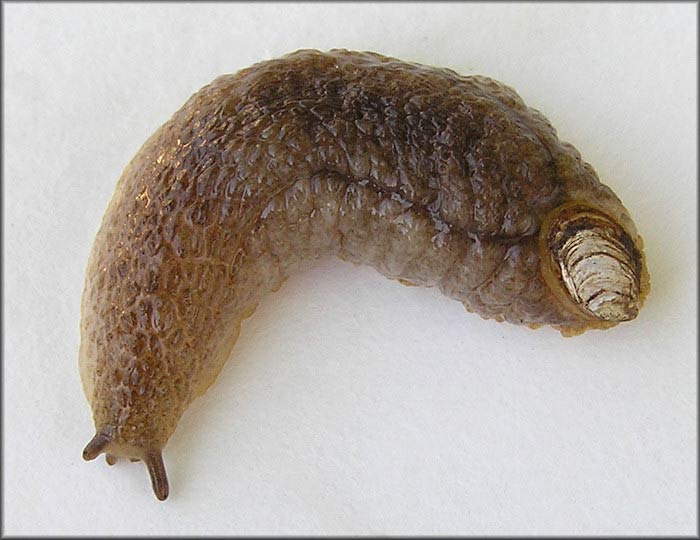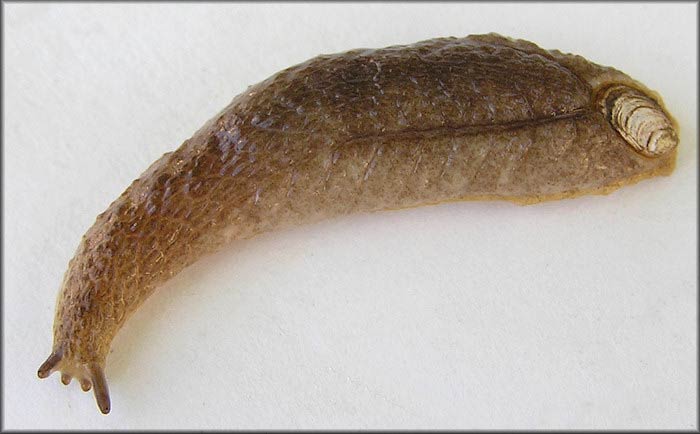Testacella haliotidea
|
Testacella haliotidea. (Photo: © R.H. Lee, Jacksonville) |
|
Testacella haliotidea. (Photo: © R.H. Lee, Jacksonville) |
Family
Testacellidae
Species
Testacella haliotidea Draparnaud, 1801
Common name
Shelled slugSlug:
A snail that either does not possess a shell or has one that is very reduced (no definite coiling) or internal.
, Earshell slug
Description
The length of this semi-slugSemi-slug:
A snail that possess a very reduced (no definite coiling) or small shell, that is often located on the posterior edge of the mantle. The animal is not able to retract into this minute shell.
ranges from 80-120 mm. The body of this animal is light grayish-brown (sometimes yellowish), with a pale footFoot:
The muscular organ on the undersurface of the body of a mollusc upon which the animal rests or uses to crawl.
fringe and sole. The small (approx. 7-8 x 5-6 mm) external shellShell:
A hard, inflexible, calcareous or chitinous structure that vary in size and may either completely encasing the animal, covering some part of it or be internal.
of this animal is located on the dorso-posterior tip of the tail. Members of this group (Testacellidae) characteristically have two distinct, lateral (branched) grooves that originate from the anteriorAnterior:
Directional term: located in front. Nearer the head or front end of a shell.
margin of the much-reduced shellShell:
A hard, inflexible, calcareous or chitinous structure that vary in size and may either completely encasing the animal, covering some part of it or be internal.
.
Two addition species in this group have been reported from Europe and may be distinguished by the following characters:
T. haliotidea: Morphology-the dorsal lateral grooves are approximately 2 mm apart at the point of origin. Genitalia-the penis has a flagellum and the spermathecal duct is short and thick.
T. maugei: Morphology-shell larger than both species (12-16 mm long by 6-7 mm wide) and the dorsal lateral grooves are approximately 5 mm apart at the point of origin. Genitalia-the penis does not have a flagellum, and the spermathecal duct is long and thin.
T. scutulum: Morphology-the shellShell:
A hard, inflexible, calcareous or chitinous structure that vary in size and may either completely encasing the animal, covering some part of it or be internal.
is of similar size to that of T. haliotidea and the dorsal lateral grooves join (just under the shellShell:
A hard, inflexible, calcareous or chitinous structure that vary in size and may either completely encasing the animal, covering some part of it or be internal.
) before reaching the the point of origin. Genitalia-the penis does not have a flagellum and the spermathecal duct is intermediate between those of T. haliotidea and T. maugei.
Native range
Western Europe and Western Mediterranean region
Distribution
North America:
- U.S.: California
- Canada
Australia: Australia, New Zealand
Europe
Caribbean: Cuba
Ecology
This carnivorous semi-slugSemi-slug:
A snail that possess a very reduced (no definite coiling) or small shell, that is often located on the posterior edge of the mantle. The animal is not able to retract into this minute shell.
spends most of its time underground, where it hunts and consumes earthworms, snails and slugs. The shelled slugSlug:
A snail that either does not possess a shell or has one that is very reduced (no definite coiling) or internal.
is commonly found in disturbed habitats like gardens, parks and agricultural fields. This slugSlug:
A snail that either does not possess a shell or has one that is very reduced (no definite coiling) or internal.
is able to burrow to depths of up to one meter during periods of aestivation. This animal has not been reported to feed on plant material and as such should not pose a threat to agricultural produce. The ecological impact that this species may have on other terrestrial mollusk species has not been documented.
Synonyms
References
Anderson 2005Anderson 2005:
Anderson, R. 2005. An annotated list of the non-marine Mollusca of Britain and Ireland. Journal of Conchology 38: 607-637.; Barker 1979Barker 1979:
Barker, G.M. 1979. The introduced slugs of New Zealand (Gastropoda: Pulmonata). New Zealand Journal of Zoology. 6: 411-437.; Barker 1989Barker 1989:
Barker, G.M. 1989. Slug problems in New Zealand pastoral agriculture. In: I.F. Henderson, Editor, Slugs and Snails in World Agriculture. British Crop Protection Council Monograph No. 41, BCPC, Thornton Heath (1989), pp. 59-68.; Kerney et al. 1979Kerney et al. 1979:
Kerney, M.P., R.A.D. Cameron and G. Riley. 1979. A field guide to the land snails of Britain and North-west Europe. Collins, London. pp. 288.; McDonnell et al. 2009McDonnell et al. 2009:
McDonnell, R.J., T.D. Paine and M.J. Gormally. 2009. Slugs: A guide to the invasive and native fauna of California. University of California, Division of Agriculture and Natural Resources 8336.



